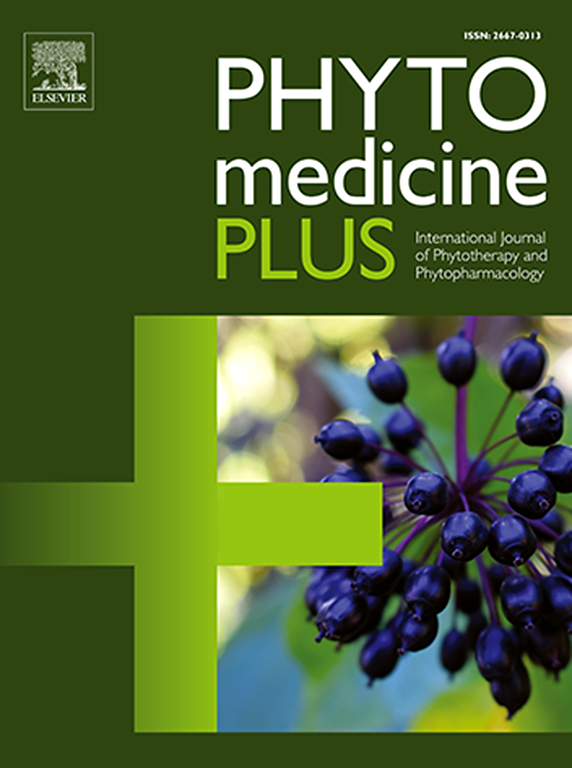灌注乙二醛交联壳聚糖-胶原支架的四棱松正己烷提取物可诱发早期骨诱导作用
Q3 Pharmacology, Toxicology and Pharmaceutics
引用次数: 0
摘要
背景用天然材料诱导成骨细胞的活性可能会消除毒性问题,并可作为再生药物开发研究的一种更好的方法。Cissus quadrangularis Linn.(CQ)提取物是β-谷甾醇、植物雌激素、β-胡萝卜素、类黄酮等的良好来源、研究设计在临界大小的大鼠腓骨缺损模型中验证乙二醛交联、机械加固、注入 CQ 己烷提取物的壳聚糖-胶原支架(CHCOHE)的体内骨再生潜力。(对照组:材料和方法按照我们最近报告的程序制备乙二醛交联壳聚糖-胶原支架。在小腿背侧用穿刺刀凿出一个临界大小的缺损(直径 6 毫米×厚度 2 毫米)。创建 6 毫米临界大小的腓骨缺损,然后将支架(CHCOHE 和 CHCO)植入缺损处。SHAM 作为阴性对照。结果对 CHCOHE 植入大鼠临界大小腓骨缺损的组织病理学评估表明,4 周后存在成骨细胞、新生血管以及巨细胞降解支架的证据。持续检查表明,12 周后,在缺损部位的中间和外围区域都形成了成熟的片状骨。虽然单独使用 CHCO 支架也能促进愈合,但 CHCOHE 组新骨形成的定量评估明显高于 CHCO 组。结论:本研究强调了 CQ 己烷提取物(即使浓度很低)的高能力以及乙二醛交联壳聚糖-胶原天然支架作为一种潜在的骨诱导生物可降解支架在修复临界大小骨缺损方面的功效。本文章由计算机程序翻译,如有差异,请以英文原文为准。

Cissus quadrangularis L. hexane extract infused glyoxal cross-linked chitosan-collagen scaffold elicits early osteoinduction
Background
The induction of osteoblast activity by natural materials would possibly eliminate toxicity concerns and can serve as a better approach for regenerative drug development studies. Cissus quadrangularis Linn. (CQ) extract is a good source of β-sitosterol, phytoestrogens, β-carotene, flavonoids, etc., and aqueous CQ extract is traditionally used for bone fracture healing.
Purpose
This study presents histopathological evidence for the significant osteoinductive potential of CQ hexane extract in a mechanically reinforced natural scaffold in rat models of critical sized calvarial defects.
Study design
To validate the bone regeneration potential of glyoxal cross-linked, mechanically reinforced, CQ hexane extract-infused chitosan-collagen scaffold (CH![]() CO
CO![]() HE) in vivo in a critical-size rat calvarial defect model. (Controls: SHAM (defect without scaffolds) operated control and chitosan collagen scaffold (CH
HE) in vivo in a critical-size rat calvarial defect model. (Controls: SHAM (defect without scaffolds) operated control and chitosan collagen scaffold (CH![]() CO)).
CO)).
Materials and methods
Glyoxal cross-linked chitosan-collagen scaffold is prepared as per the procedure we have reported recently. A critical-size defect (6 mm diameter × 2 mm thickness) was made at the dorsal calvarium using a trephine burr. The 6 mm critical sized calvarial defects were created and the scaffolds (CH![]() CO
CO![]() HE and CH
HE and CH![]() CO) were implanted into the defect. SHAM served as a negative control. The animals were sacrificed after 4 and 12 weeks to analyze the extent of new bone formation.
CO) were implanted into the defect. SHAM served as a negative control. The animals were sacrificed after 4 and 12 weeks to analyze the extent of new bone formation.
Results
Histopathological evaluation of CH![]() CO
CO![]() HE implanted critical-size calvarial defect in rats indicates the presence of osteoblast cells, neovascularization along with evidence of scaffold degradation by giant cells after 4 weeks. Continual examination designates the formation of mature lamellar bone formation at 12 weeks both in the middle and periphery regions of the defect site. Although CH
HE implanted critical-size calvarial defect in rats indicates the presence of osteoblast cells, neovascularization along with evidence of scaffold degradation by giant cells after 4 weeks. Continual examination designates the formation of mature lamellar bone formation at 12 weeks both in the middle and periphery regions of the defect site. Although CH![]() CO scaffold alone also promoted healing, the quantitative assessment of new bone formation is significantly greater for CH
CO scaffold alone also promoted healing, the quantitative assessment of new bone formation is significantly greater for CH![]() CO
CO![]() HE than CH
HE than CH![]() CO group. SHAM-operated controls did not elicit any new bone formation.
CO group. SHAM-operated controls did not elicit any new bone formation.
Conclusion
This study highlights the high competency of CQ hexane extract (even at a very low concentration) and the efficacy of glyoxal cross-linked chitosan-collagen natural scaffold as a potential osteoinductive biodegradable scaffold for repairing critical-size bone defects.
求助全文
通过发布文献求助,成功后即可免费获取论文全文。
去求助
来源期刊

Phytomedicine Plus
Medicine-Complementary and Alternative Medicine
CiteScore
3.70
自引率
0.00%
发文量
178
审稿时长
81 days
期刊介绍:
 求助内容:
求助内容: 应助结果提醒方式:
应助结果提醒方式:


